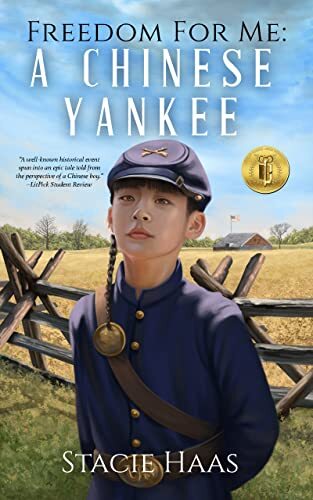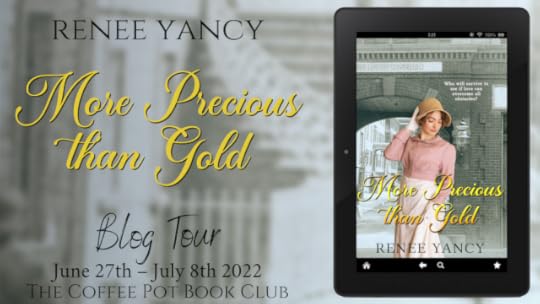Virginia Crow's Blog: Crowvus Book Blog, page 28
August 10, 2022
#HistFicThursdays - The Story of Wintercombe - Pamela Belle - Guest Post: Building Locations
Today, for my #HistFicThursdays blog, I'm delighted to be sharing a guest post from Pamela Belle as she introduces the world of Wintercombe, the setting for her series of books.
The Story of Wintercombe
I’ve always loved old houses, especially those built in the mediaeval and Tudor periods – somehow, Georgian grandeur just doesn’t do it for me. Elizabeth Bennet may have fallen in love with Pemberley, but I’d just think about all that chilly marble flooring and those high ceilings, and how difficult it would be to heat, never mind the dusting.
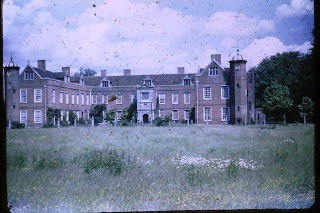 Rushbrooke Hall in Suffolk, taken in
Rushbrooke Hall in Suffolk, taken in
the 1940s
For my first historical novels, I was inspired by Rushbrooke, the house, alas no longer standing, where my mother had lived as a small child, another, similar house called Kentwell Hall, and also the perfect pocket mediaeval manor, Stokesay, in Shropshire. I had four books under my belt, and was looking for a subject for another. Then I went to stay with a friend who had just moved to Wiltshire. She took me for a drive, one chilly February morning, and said, ‘You simply must see this fabulous house.’ We drove down narrow country lanes, and pulled up outside Great Chalfield Manor, one of the most beautiful places I’ve ever seen.

The entrance front of Great Chalfield Manor in WiltshireAncient, gabled, built of the local golden-grey stone, it spoke to me of a hundred secret stories – at least one of which, I wanted to tell.
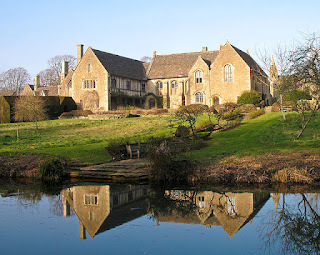 Great Chalfield, looking over the moat and gardens.
Great Chalfield, looking over the moat and gardens.In the summer, when it was open to the public (it’s owned by the National Trust), I went back, and wandered round the house and gardens, entranced by the terraces, the moat, the splendid Great Hall, and the listening masks in the walls high above, so that the lord, or the lady, could keep an eye and an ear on what was happening down below. It was the inspiration I had been looking for. Back at home, I read up on the history of the house, and found that it had hosted a garrison during the English Civil War – my favourite historical period, ever since I’d fallen in love with Prince Rupert at an impressionable age. Better and better – except that the owner of the house at the time had been an elderly widow. I wanted to write about a young woman with a family, so I used a novelist’s licence and picked up Great Chalfield and put it down in one of my favourite villages, Norton St. Philip in Somerset. I’d first visited it when I was a member of the King’s Army, doing a weekend re-enactment with my regiment in Wiltshire a few years before. On the Saturday, we’d all gone, in costume, to the George, and spent the evening singing Cavalier drinking songs in the main bar. There was a group of American tourists sitting in the corner, and I suspect they thought we put on the same show every night!
So I had my location – or so I thought, until I paid the village another visit in a wet November, and found that the field where I’d thought to put the house was two foot under flood water. Time for another look at the map, now with the actual landscape in front of me. The side of a low hill just outside Philip’s Norton (as it was known in the 17th century) was ideal. The village itself is beautiful, full of old houses which would have been standing during the Civil War, and the next stage in my research beckoned – to find out more about what it was like at that time. So off I went to the Somerset Record Office in Taunton – and there serendipity struck, because amongst their documents on Norton St Philip, there was a survey of the village made in the 1630s for Lord Craven, then the absentee Lord of the Manor.
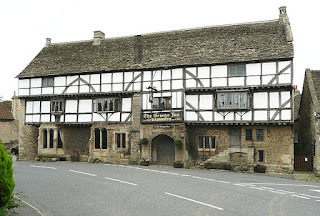 The George at Norton St PhilipEvery plot, every field, every house, every outbuilding, was listed, along with the name of the tenant, and they were all numbered: the map that had evidently once accompanied it was no longer extant, but using the survey, it was possible, and utterly fascinating, to reconstruct it, cross-referencing with the parish registers (which, in complete contrast to the beautifully written survey, looked as if a demented spider had control of the pen). By the time I’d finished, I had the names, addresses, families, social standing and, in many cases, occupations, of pretty much every tenant in Philip’s Norton during the Civil War period.
The George at Norton St PhilipEvery plot, every field, every house, every outbuilding, was listed, along with the name of the tenant, and they were all numbered: the map that had evidently once accompanied it was no longer extant, but using the survey, it was possible, and utterly fascinating, to reconstruct it, cross-referencing with the parish registers (which, in complete contrast to the beautifully written survey, looked as if a demented spider had control of the pen). By the time I’d finished, I had the names, addresses, families, social standing and, in many cases, occupations, of pretty much every tenant in Philip’s Norton during the Civil War period.Naming the house took some thought. I wanted something that would sound poetic without being too unlikely. Even that took a lot of research in place-name volumes, and eventually, after several other considerations (I rejected Honeycombe as being far too twee), I settled on Wintercombe. Its most likely meaning was ‘valley of the vines’, which for a sunlit slope seemed appropriate and right. Above all, I wanted the world I was creating to be as accurate, plausible and convincing as possible.
Of course, the danger of all that in-depth research (which was indisputably the most interesting part of planning the book) was the temptation to show off with massive info-dumps at every available opportunity. I’ve always been a history geek, but I think research should be like an iceberg – the reader should only be able to see a small part of it, but what’s invisible stops the whole edifice capsizing. A lot of those details didn’t make it into the book, but almost all the servants of Wintercombe actually existed, and sometimes I was able to use clues in the documents to give me pointers to their characters. For instance Bessie Lyteman, the flirtatious dairymaid, was the mother of not one, but two, children born out of wedlock. And the villain of the piece, Lieutenant-Colonel Ridgeley, the Royalist officer in charge of the garrison, was also a real person, and to judge from contemporary accounts, just as unpleasant as I depicted him.
I was so captivated by the St Barbe family and their beautiful house that I couldn’t stop at just one book, so I wrote three sequels, taking their story through the later years of the 17th century (when Philip’s Norton was the scene of a skirmish in Monmouth’s rebellion, an opportunity that was far too good to ignore).
And how much of me is in the central character of Silence, the quiet, unassuming Puritan wife who finds so much courage and resourcefulness in adversity? Well, like her, I’m a gardener, with a gardener’s patience, and I love children, music and animals. Whether I’d have been as brave in those circumstances is a very moot point – as one of my friends was fond of saying, ‘cowards run in my family.’ But I can certainly identify with her more than with her vain, wilful granddaughter Louise, or even with her acerbic and intellectual niece Phoebe, and she remains one of my favourite creations.
Share in the Wintercombe adventure via #KindleUnlimited here: Amazon
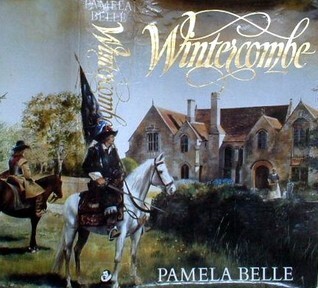
August 3, 2022
#HistFicThursdays - On Bur Oak Ridge - Jenny Knipfer - Book Excerpt
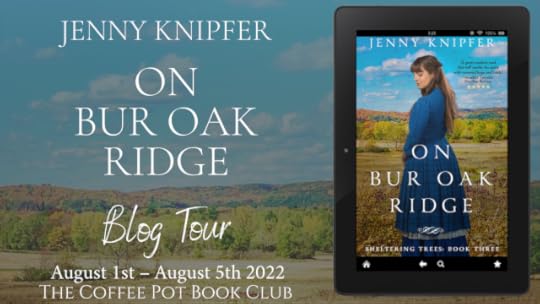
Today, I'm delighted to hosting Jenny Knipfer once more, this time with the next book in her Sheltering Trees series: On Bur Oak Ridge. I'm sharing a short extract, but first, let's meet the book...
“The plot has its twists and turns to keep readers intrigued…to the very end. A great comfort read that will soothe the spirit with renewed hope and faith.” Readers’ Favorite five-star review
A HISTORICAL NOVEL OF FINDING HEALING AND A SECOND CHANCE AT LOVE
In the early 1900s, quiet and reserved Molly Lund finds refuge from her past at the Nelsons’ farm in Minnesota. In an attempt to turn a new page in her life, Molly works at making peace with her losses and coming to terms with the disfiguring burns on her face.
Samuel Woodson, the Nelsons’ hired hand, carries his own cares. Split from his family and bearing a burden of misplaced guilt for an act that haunts him, Samuel – seeing past Molly’s scars – draws her out of her self-protective shell.
Molly and Samuel form a friendship, but just as their hearts lead them deeper, an unexpected guest comes calling, demanding what’s his.
Will Molly and Samuel find a way to be together or will they be separated, due to impediments beyond their control? Can they trust in God’s plan and travel a path that heals the hurts of the past?
Readers of historical fiction, Christian historical fiction, and Christian historical romance will delight in this beautifully wrought story of the healing power of love.
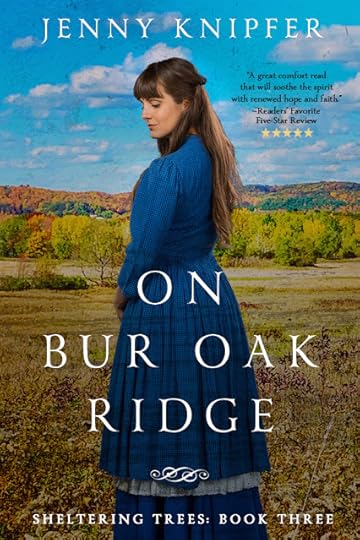
Praise for On Bur Oak Ridge:
“A heartwarming story of healing from external and internal scars. Through some of life’s harder lessons the characters learn to trust, forgive, and find second chances out of the ashes of pain and loss.” Anne Perreault, author of eighteen inspirational novels, including the Yellowstone series
On Bur Oak Ridge also has a book trailer, which you can watch here!
On Bur Oak Ridge is available on #KindleUnlimited and you can find it on this Universal Link.
Here's a little excerpt to whet your appetite:
Molly
For the first time in years, I will leave behind the walls of my strange shelter: the asylum. Tomorrow I board a train to visit Mabel, my friend. I’ll wear a mourning veil in public, so people won’t gawk or reel back in revulsion at the naked sight of my face. I grieve the worst when the children cry; then I become a nightmare to some poor little soul. I hate that: adding to another’s fear. We all bear enough.
My lungs command a deep breath, and I reach to turn down the lamp. The future comes tomorrow whether I am ready or not.
“Ready or not!” The words stab me in the throat, and I feel as if I’m being basted with a sharp needle. Those were Lonny’s last words. My eyes roll shut, and I see the flash of white, the brown, curly head, the grin before he turned, the crash of the poles, like the blast of a mighty horn. I wanted to scream, but my voice caught in my throat, choking me. My mouth hung open, but all that came out was silence.
I breathe, in and out slowly, like the doctor taught me. The visions recede.
My eyes open. The room has been thrown under a dark caul, and I realize I must have turned down the wick of the kerosene lamp. Now my face looks ghostly in the slightly spotted, silver- backed glass. I move to the bed, jump in, and tuck the covers up to my chin, praying I won’t dream of Lonny.
Please, God. Not tonight.
Now, let's meet the author, Jenny Knipfer...
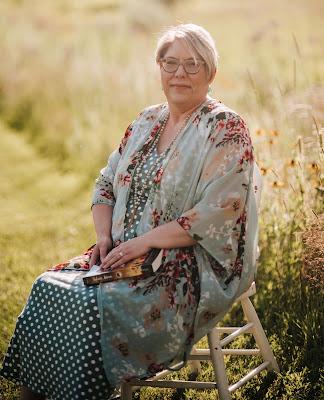
Jenny lives in Wisconsin with her husband, Ken, and their pet Yorkie, Ruby. She is also a mom and loves being a grandma. She enjoys many creative pursuits but finds writing the most fulfilling.
Spending many years as a librarian in a local public library, Jenny recently switched to using her skills as a floral designer in a retail flower shop. She is now retired from work due to disability. Her education background stems from psychology, music, and cultural missions.
All of Jenny’s books have earned five-star reviews from Readers’ Favorite, a book review and award contest company. She holds membership in the: Midwest Independent Booksellers Association, Wisconsin Writers Association, Christian Indie Publishing Association, and Independent Book Publishers Association.
Jenny’s favorite place to relax is by the western shore of Lake Superior, where her novel series, By The Light of the Moon, is set.
She deems a cup of tea and a good book an essential part of every day. When not writing, Jenny can be found reading, tending to her many houseplants, or piecing quilt blocks at her sewing machine.
Her new historical fiction, four-part series entitled, Sheltering Trees, is set in the area Jenny grew up in, where she currently lives, and places along Minnesota’s Northern Shore, where she loves to visit. She is currently writing a four-part novella series entitled: Botanical Seasons and a three-part fantasy series entitled: Retold Fairy Tales.
You can find Jenny on these social media links: Website - Twitter - Facebook - BookBub - Amazon Author Page - Goodreads - Instagram - Pinterest
Keep up with the rest of Jenny's tour by clicking on the banner below:
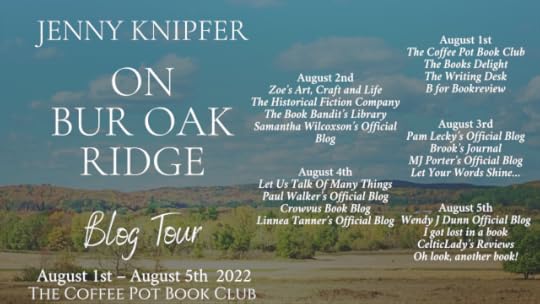
July 27, 2022
#HistFicThursdays - Freedom For Me: A Chinese Yankee - Stacie Haas - Book Review

I've always been interested in Americana, although that comes in waves, so occasionally I'll be poring over the biographies of various presidents and then the following week my fascination has waned completely. It does mean that I was reasonably familiar with the Civil War background of the book, which made me very enthusiastic to read it.
It is grounded in American history - and of course it should be: Freedom for Me is inspired by the true story of a young Chinese man who signed up to fight for the north in the American Civil War. More than complex military strategy or groundbreaking historical moments, this is the story of one boy's decision to fight, and how his reasons for fighting mature and develop over time.
I loved reading about how Thomas, the main character, began to learn about himself in the context of others. His closest relationship is with his brother, but he develops deep and meaningful friendships with his brothers-in-arms and with an runaway slave, Sam. The characters were well-developed and rounded, and I found it fascinating how Thomas became closer to - the quite frankly loathsome - Henry as time went by.
Character development drives this story and, despite it being set in the 1860s, young people reading it today will find that it still resonates. This is the story of learning who you are and what can drive you to do incredible things. But it's also the story of how racism seeps into everyday life and just what a complex issue it really is.
Occasionally the plotline was predictable (or maybe I should just own-up to having read so many of these brothers-in-arms stories that I can point to a character from the first time you meet them and say "yep, they're not making it to the end of the book") but this doesn't in any way hamper the enjoyment of Freedom For Me. If I had to mention one little niggle, it would be the use of "ya" instead of "you" - absolutely fine but it was occasionally inconsistent. Still, not enough to spoil the enjoyment of what is a lovely but challenging read.
In summary, book which does justice to the many individuals who fought in the American Civil War, and which addresses friendship and camaraderie in a way which never shies away from big issues.
Blurb
Civil War is raging in America and fifteen-year-old Thomas Beck doesn’t quite fit in. He’s neither black nor white, slave nor free, and yet, Thomas dreams of becoming a Yankee and joining the fight for freedom. After successfully sneaking into the Union Army, Thomas gets his wish, but he’s a Chinese Yankee—different in looks and hairstyle, but not in heart. Finding himself unwelcome by either blue or gray, Thomas forms an unlikely friendship with a runaway slave as the fight moves toward a pivotal moment in Gettysburg.
Freedom for Me is a historical novel based on a real Chinese Yankee, one of only a few who served in the American Civil War. Children’s Literary Classics award winner for coming-of-age and historical fiction and a Skipping Stones honoree for multicultural teen fiction.
You can find the book on Amazon
Social Connections
Twitter:@staciehaas
Facebook: https://www.facebook.com/authorstaciehaas
Author's Website: https://www.staciehaas.com/
July 21, 2022
#HistFicThursdays - Horrible Histories 7 - Love Rats
It was my birthday at the start of July, and I knew exactly how to celebrate in style! While most people might choose to celebrate their 37th birthday by going for a drink or out to the theatre or any such adventure, I stayed home and celebrated by watching the Horrible Histories songs in chronological order on a three-hour marathon of musical history! We attempted to remember them all in order (and did a reasonable job!), but the only one we missed was this one.
In an attempt to redress the balance, I've opted to cover it in this month's blog!
Unlike the other songs we've had, which focus on one person or time period, this song gives us a cross-section of times. It stars Henry VIII, Nero, William I, Cleopatra, and Edward VIII, and two very cute little rats! As the title suggests, it assesses each of these rulers as lovers (no, not like that!), with their romantic relationships - or "unromantic", as the case might be!
I really believe Henry VIII loved Catherine of Aragon. He remained married to her for ten years after the birth of Mary I before he began searching to annul the marriage and, when he finally divorced her, it was not only at the expense of their relationship, it also served to provide a schism between England and much of Europe. With regard to his relationships, they now began spiralling out of control and he got through wives at a dramatic rate. He certainly was a rat when it came to affairs of the heart, and seemed to have only thoughts for himself regarding each and every one of his relationships.
It's a little bit hard to work out what Nero was doing - the man was somewhat of a lunatic! Despite the likelihood of Poppaea's death being his fault, he appears to have loved her in his own peculiar way. Following her death, she received a spectacular funeral, and was awarded divine honours. His third wife, like Henry VIII's Catherine Parr, was more shrewd than her predecessors and ultimately outlived her husband and retained a certain level of dignity in doing so.
William I, or William the Conqueror, was not such a fatal love rat, but today there would certainly be a case against him for domestic abuse! In The Year We Lived, his early indiscretions have sired significant children within the family of Matilda, who he later married. There's no proof that this happened but then there's no proof it didn't! It certainly made for an interesting development in the book. Matilda was a clever partner, shrewd and persuasive to her husband's fiery temper, and she appears to have had a knack for establishing peaceful relationships with the use of words and diplomacy.
Traveling back in time again (this song is a bit like a pinball machine), the song turns to Cleopatra. We get an image of Antony and Cleopatra as being akin to the star-crossed lovers of Shakespeare's Romeo and Juliet, but she did not take her life for love, but to escape being a spectacle in Octavian's triumph. I suspect, had this not been on the cards, she would have found another husband and continued in her quest for domination.
And then, as proof not all romances of rulers were violent or deadly, the song presents Edward VIII. While his marriage to Wallis Simpson certainly sparked a romantic chord in the hearts of the population, it also showed a distinct weakness in the royal family, in that they were no longer willing to offer their all to the role their birth had dictated. With hindsight, it was a good move, as Edward VIII was a Nazi-sympathiser and was threatened with a court-martial if he failed to return to British lands.
From my own experience of writing and reading historical and fantasy fiction, we all like to imagine fairytale endings for our kings and queens. In actual fact, although the first four of these are amongst the worse there were, romance was not high on the list of priorities for a ruler - if it made the list at all! People have tried to romanticise the six wives of Henry VIII, or the double suicide of Antony and Cleopatra, but there is plenty to suggest these relationships owed as much to self-interest as love.
They do, however, provide us with great insights into the actual relationships and how much was at stake in them. Perhaps you write of rulers, or perhaps you write of the ordinary person. Whichever it is, remember the behaviour of the ruling class filters through to the lower classes. Plenty of people witnessed the Duke of Normandy dragging Matilda by her hair, or Edward VIII's abdication by way of a growing media power. It is not unrealistic to say that, by merit of their leaders, these times of love rats were tumultuous in affairs of the heart!
July 13, 2022
#HistFicThursdays - The Girl from Bologna - Siobhan Daiko - Guest Post

It's #HistFicThursdays, and I'm so excited to be sharing a guest post from Siobhan Daiko, as part of her Coffee Pot Book Club tour. Find out all about Siobhan's research for her fantastic book The Girl from Bologna and the creation of that fantastic tagline: "the past is never past". But first, let's meet the book..
Blurb
Bologna, Italy, 1944, and the streets are crawling with German soldiers. Nineteen-year-old Leila Venturi is shocked into joining the Resistance after her beloved best friend Rebecca, the daughter of a prominent Jewish businessman, is ruthlessly deported to a concentration camp.
In February 1981, exchange student Rhiannon Hughes arrives in Bologna to study at the university. There, she rents a room from Leila, who is now middle-aged and infirm. Leila’s nephew, Gianluca, offers to show Rhiannon around but Leila warns her off him.
Soon Rhiannon finds herself being drawn into a web of intrigue. What is Gianluca’s interest in a far-right group? And how is the nefarious head of this group connected to Leila? As dark secrets emerge from the past, Rhiannon is faced with a terrible choice. Will she take her courage into both hands and risk everything?
An evocative, compelling read, “The Girl from Bologna” is a story of love lost, daring exploits, and heart wrenching redemption.
The Girl from Bologna is available on #KindleUnlimited via this Universal Link

Guest Post
Thank you so much for inviting me to talk about the historical aspects of The Girl from Bologna on the Crowvus Book Blog. It’s an honour to be here.
The hardest thing about the research for this book was that I needed to read several books in Italian to make sure the background to my story was accurate. I live in Italy and once studied Italian at university, but it was still a hard slog reading in a language not my own.
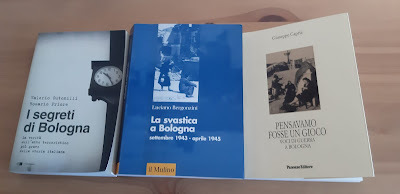 Three of the books I read in Italian
Three of the books I read in Italian
The more I researched, the more immersed I became in the events. What happened to the urban guerrillas, fighting both against the Nazi occupation and against the fascists in Bologna, was truly harrowing. They grouped in the city when it appeared that the Allies were on the cusp of breaking through German lines in the autumn of 1944 and were caught like sitting ducks by the Nazi-fascists when the Anglo-Americans halted their advance. Making my characters go through the terrible repercussions brought tears to my eyes. And, if that wasn’t bad enough, war returned to Europe while I was writing the story, making it particularly poignant and relevant.
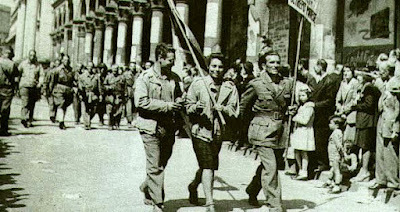 Partisans after the liberation of Bologna
Partisans after the liberation of Bologna
The Girl from Bologna is set during two historical time periods. The first, during the final years of World War II, and the second in the spring of 1981. I loved writing about the developing friendship between my two heroines. Leila, the freedom fighter in 1944-5, rents out a room to a young Welsh student in 1981. They form an immediate bond and I enjoyed bringing their rapport alive on the page.
I decided to write “The Girl from Bologna” after I visited Bologna with my husband and saw the monument to the partisans in Piazza del Nettuno. I found the photos of the young men and women who’d died for freedom deeply moving. The more I read about what happened in the red city after the Allies stalled their advance, the more my heart broke for those brave partigiani. I hope I’ve managed to convey the magnitude of their sacrifice adequately to my readers. War returned to Europe while I was writing this novel and many of the feelings expressed by Leila are shared by me. “The past is never past” is so true.
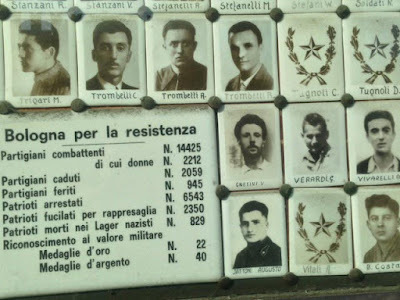 Section of the monument to the partisans in Piazza del Nettuno, Bologna, showing the number of partisans14,425. 2,212 women. 2059 fallen. 945 wounded. 6543 arrested. 2350 shot in reprisals. 829 died in Nazi camps. 22 gold bravery medals. 40 silver bravery medals.
Section of the monument to the partisans in Piazza del Nettuno, Bologna, showing the number of partisans14,425. 2,212 women. 2059 fallen. 945 wounded. 6543 arrested. 2350 shot in reprisals. 829 died in Nazi camps. 22 gold bravery medals. 40 silver bravery medals.
Now, let's meet the author:
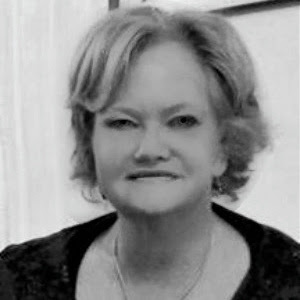
Siobhan Daiko is a British historical fiction author. A lover of all things Italian, she lives in the Veneto region of northern Italy with her husband, a Havanese dog and a rescued cat. After a life of romance and adventure in Hong Kong, Australia and the UK, Siobhan now spends her time indulging her love of writing and enjoying her life near Venice.
You can follow Siobhan on these links:
Website - Twitter - Facebook - LinkedIn - Pinterest - Instagram - BookBub - Amazon Author Page - Goodreads
Keep up with the rest of the The Girl from Bologna tour stops by clicking on the banner below:
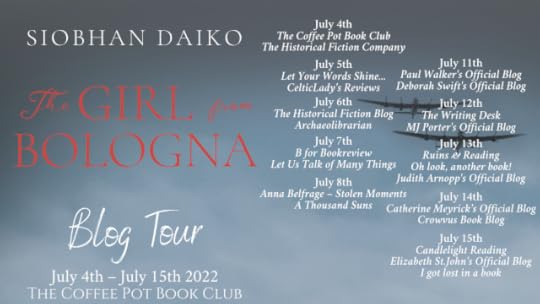
July 7, 2022
#HistFicThursdays - Leningrad: The People's War - Rachel R. Heil - Guest Post
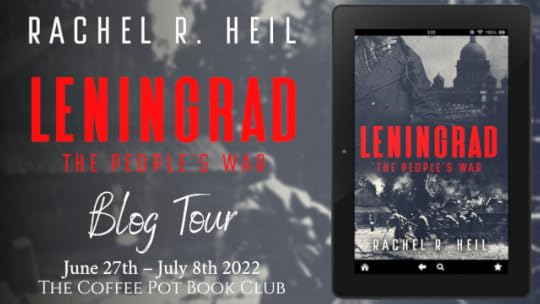
It's a double #HistFicThursdays today! For the second blog of this week I'm delighted to be sharing a guest post from Rachel R. Heil, as part of her Coffee Pot Book Club tour. Find out all about Rachel's inspiration and the balance between historical fiction and historical fact in Leningrad: The People's War. But first, let's meet the book..
Blurb
Leningrad, 1941. As Europe crumbles under the German war machine, the people of the Soviet Union watch. There are whispers of war but not loud enough for the civilians of Leningrad to notice. Instead, they keep their heads down and try to avoid the ever-watching eyes of their own oppressive government.
University student Tatiana Ivankova tries to look ahead to the future after a family tragedy that characterizes life under the brutal regime. But, when the rumors that have been circulating the country become a terrifying reality, Tatiana realizes that the greatest fear may not be the enemy but what her fellow citizens are prepared to do to each other to survive.
As his men plow through the Russian countryside, Heinrich Nottebohm is told to follow orders and ask no questions, even if such commands go against his own principles. His superiors hold over him a past event that continues to destroy him with every day that passes. But, when given the opportunity to take an act of defiance, Heinrich will jump at the chance, ignoring what the end results could be.
Leningrad: The People’s War tells the harrowing beginning of a war that forever changed the landscape of a city, told through the eyes of both sides in a tale of courage, love, and sacrifice.
Leningrad: The People's War is available on #KindleUnlimited via this Universal Link
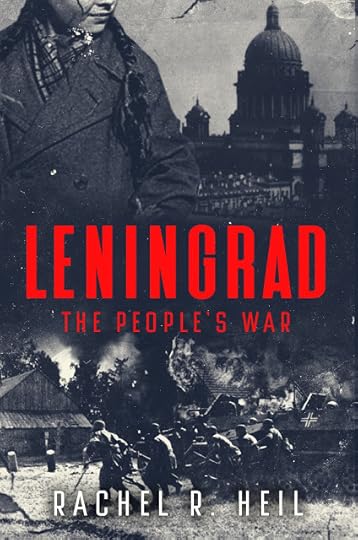
Guest Post
When I decided to become a writer there was little doubt in my mind about what genre I was going to write in. I enjoy a heart-pounding mystery, a nail-biting thriller, and a well done nonfiction piece, but historical fiction has always been the genre I’ve been drawn to. Plus, as a self-professed history nerd it would seem blasphemous to write anything else. But one of the challenges I faced was how do I keep a writer’s attention when they probably already know what’s going to happen? After all, most readers have 20:20 hindsight vision, especially when it comes to very well-known events like World War Two.
To answer such a question I asked myself what, as a reader, keeps me invested in a story? I’ve always been someone fascinated by personal stories. Whether it’s set in occupied France or communist Romania against the backdrop of the Iron Curtain, I find myself drawn to the characters’ stories and how they attempt to navigate the world they are living in. In such situations we tend to ask ourselves, what would I do? Would I be willing to sacrifice my entire future to speak out against something I see as an injustice, or would I quietly live my life and try to get by? Those types of questions have always fascinated me. As a writer I can’t manipulate the history of what happens in the set time period, but I can dictate what happens to the characters, and that’s what I use to deal with a reader’s knowledge of the event.
The reader knows, or can know, what’s going to happen with the larger event. With World War Two, the reader knows Nazism will collapse and the Allies will be victorious. But the reader doesn’t know what is going to happen to the fictional character. Are they going to make it through the war? Will they fight for their country? Will their faith in their leader be shaken or remain steadfast? Are they going to be betrayed by that strange side character who you can't quite figure out but you don't trust them for some unexplainable reason? Or are they going to surprise you and help out the protagonist? In the case of Leningrad: The People’s War the reader will ask themselves if the characters are going to survive the harsh siege or die before they are eventually liberated and is that liberation because the city falls to the Germans and the people are subjected to occupation or are the Germans continually propelled back and never enter Leningrad (you can Google that if you really want or you can read Leningrad to find out😊).
However, the characters in Leningrad are not entirely fictional. Many of the challenges and decisions they have to make are based on ones actual people in Leningrad and what those serving in the German Army had to face. That is what I love about researching any event, and it goes back to my love for personal stories. Reading and listening to survivors’ testimonies on what they encountered during the period is extraordinarily valuable, and they help provide a sense of realism to the character. Sometimes this can be a little complicated when taking into consideration readers' knowledge of events. For example, during the war, Leningrad was a city always ripe with rumors, some of which were not at all true, and the reader would know this. One rumor that swirled around Leningraders was that Hitler wasn't going to destroy Leningrad because he planned on gifting the city to his daughter. Of course, we know that Hitler never had children, but it's an example of what Leningraders were saying to each other during that time. Ultimately, while my characters’ decisions and actions are purely fictional to help propel the story the way I want it to go their origins are rooted in true survivors’ stories.
I think it is hard to counter the reader's foresight of events, but I think the best way of keeping readers engaged is to create characters they care about. Most stories are character-driven, and each one has a story behind them that is waiting to be told.
Now, let's meet the author:
 Rachel R. Heil is a historical fiction writer who always dreamed of being an author. After years of dreaming, she finally decided to turn this dream into a reality with her first novel, and series, Behind the Darkened Glass. Rachel is an avid history fan, primarily focused on twentieth century history and particularly World War Two-era events. In addition to her love for history, Rachel loves following the British Royal Family and traveling the world, which only opens the door to learning more about a country's history. Rachel resides in Wisconsin.
Rachel R. Heil is a historical fiction writer who always dreamed of being an author. After years of dreaming, she finally decided to turn this dream into a reality with her first novel, and series, Behind the Darkened Glass. Rachel is an avid history fan, primarily focused on twentieth century history and particularly World War Two-era events. In addition to her love for history, Rachel loves following the British Royal Family and traveling the world, which only opens the door to learning more about a country's history. Rachel resides in Wisconsin.You can follow Rachel on these links:
Twitter - Facebook - LinkedIn - Instagram - BookBub - Amazon Author Page - Goodreads
Keep up with the rest of the Leningrad: The People's War tour stops by clicking on the banner below:
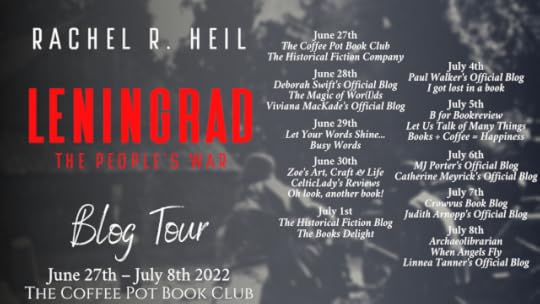
July 6, 2022
#HistFicThursdays - More Precious Than Gold - Renee Yancy - Guest Post
It's #HistFicThursdays again, and this week I'm delighted to be sharing a guest post from Renee Yancy, as part of her Coffee Pot Book Club tour. A little over 100 years later, we are once more in a pandemic. Find out about the inspiration and backdrop Renee used for More Precious Than Gold in her guest post below. But first, let's meet the book..
Blurb
A young woman refuses to become a pawn in her grandmother’s revenge scheme and forgoes a life of wealth and royalty to pursue a nursing career as America enters WWI and the Pandemic Flu of 1918 wreaks havoc in New York City.
More Precious Than Gold is available via Amazon UK - Amazon US - Amazon CA - Barnes & Noble - Kobo - Apple Books
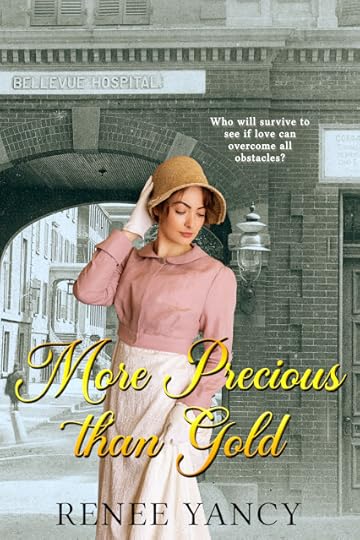
Guest Post
The Pandemic Flu of 1918 affected not just the lives of Bellevue nurses but nearly the entire world.
The administration of Bellevue Hospital gave their student nurses the option of going home while the deadly Pandemic Flu of 1918 raged through New York City. Not a single one of Bellevue’s student nurse chose to leave.
And eleven of those student nurses lost their lives while serving their patients.
That’s dedication.
My historical novel, More Precious Than Gold, takes place against the background of WWI and the Pandemic Flu.
My protagonist, Kitty Winthrop, eighteen years old, is a student nurse at Bellevue Hospital in New York City.
It is difficult today to imagine the horror of the situation these student nurses found themselves in. Antibiotics hadn’t been discovered yet, and the treatment regimen for flu patients consisted of aspirin, fluids, and morphine or laudanum. Overwhelmed by the sheer number of patients, the nurses could barely keep up with the all the blood and bodily fluids produced by the sick and dying.
The Pandemic Flu of 1918 depressed the average life expectancy of adults in the US by almost 10 years.The graph displays data from the years 1910 to 1960. Research on the Pandemic Flu of 1918 continues to the present day.
I finished the manuscript for this story in 2018, two years before COVID hit. Never in a million years did I think I would ever find myself in the middle of a modern day pandemic. Some of the similarities are eerie. And some things that people in 1918 experienced didn’t happen here, thank the Lord.
Now, let's meet the author:
 Renee Yancy is a history and archaeology nut who works as an RN when she isn’t writing historical fiction or traveling the world to see the exotic places her characters have lived.
Renee Yancy is a history and archaeology nut who works as an RN when she isn’t writing historical fiction or traveling the world to see the exotic places her characters have lived.A voracious reader as a young girl, she now writes the kind of books she loves to read—stories filled with historical and archaeological detail interwoven with strong characters facing big conflicts. Her goal is to take you on a journey into the past so fascinating that you can’t put the story down.
When she isn’t writing, Renee can be found in the wilds of Kentucky with her husband and a rescue mutt named Ellie. She loves flea markets and collecting pottery and glass and most anything mid-century modern.
You can follow Renee on these links:Website - Twitter - Facebook - BookBub - Instagram - Pinterest - Amazon Author Page - Goodreads
Keep up with the rest of the More Precious Than Gold tour stops by clicking on the banner below:
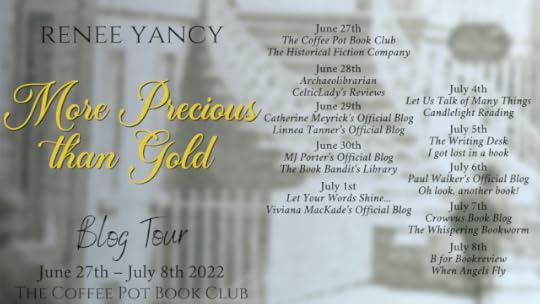
June 29, 2022
#HistFicThursdays - Horrible Histories 6 - Vikings
Today's #HistFicThursdays blog is a little bit different. The Horrible Histories songs I've shared so far have all been about specific people. Today, we're looking a little bit broader...
Meet the Vikings:
I have to say, the song above is my favourite Horrible Histories song! Both the songs in today's blog are my sort of music, even though they're not a lot like each other. But the music matches the theme and - without talking too much about the genius of the musicianship (my day job coming into play here) - these two songs show two very different sides of the Viking impact on Britain.
The song above is what we are led to believe all Vikings were like. A couple of years ago, on a return from my sister's book launch in North Lincolnshire, we visited Lindisfarne. It is commercialised now, not a great deal like the Holy Island the monks had established there (although the earliest reference to this name appears to have been some 200 years after the Viking raid). But, if you're able to escape the throng of people for a second, it is worth just staring out across the water and trying to imagine how calm it must have been and how incredibly terrifying it became as summer arrived accompanied by a brutal and unprovoked attack.
Lindisfarne may not have been the Vikings' first visit to Britain, but it was certainly the one which caused the biggest impact.
In the song, they explain that "comets crossed the sky that night", but I prefer the take of the Anglo-Saxon Chronicles that fiery dragons were seen flying through the sky. It is incredible how these superstitions carried such weight at that time. Omens, and the interpretation of them, played a significant part in everyday life. In The Year We Lived, Robert (half Saxon, half Dane) finds himself caught between these two conflicting worlds when he is confronted with the return of the white hart. Any page of these Saxon annals will reveal the presence of an omen somewhere along the way and, after the events of 793, they were wise to look out for them.
One can almost imagine that, as the dragon was seen in the heavens, the Saxons read it as a threat while the Vikings beheld it as a blessing. After all, many daring figures in Norse mythology would set out to slay dragons and collect their hoard, and the hoard of church wealth which they found at Lindisfarne must have seemed like a fulfillment of this. Having spent my childhood in Orkney, I was very familiar with one of the most famous pieces of historic graffiti: the Maeshowe Dragon, etched into the stone of the neolithic tomb, a token left by the Vikings who raided it. We know they took shelter there, perhaps the dragon was added as a guardian of something left behind, or perhaps it was a picture of who met them there.
But, while this is the lasting image of the Vikings, their lasting legacy is another matter. Time for another song!
One of the strangest things about studying "The Vikings" as a topic at school, was how different the same topic was on moving south of the border. Living in Orkney, then moving to North Lincolnshire, my schools were all in Viking heartland. But what a different tale there was to tell across these two hotbeds of Scandinavian invasion! In the song, they talk about splitting the "isles diagonally from southeast to northwest" [and then they say that Alfred ruled the rest, but don't even get me started on how erroneous that line is], and this shows just how big a gap between the Danes and the Norse Vikings there was. If there was a physical gap like this, it stands to reason there was an equally sizeable cultural gap.
But this song makes a good point. The Vikings were not just invaders. They settled and integrated with the native people. By the time The Year We Lived is set, Robert's Hall is a mixed collection of Saxons, Danes, and Normans within the Fenland, and this was how the Scandinavians stretched their own culture into the what was to become the jumble of modern Britain.
I love that this song makes reference to place names, too, although one of the most common suffixes of Viking decent in this part of Scotland is missing from it: -ster. Crowvus HQ is situated in StempSTER, a sure sign that, despite having a settlement on this site which predates the Vikings (the broch at the bottom of the garden!), it was the Vikings who created the farmstead which has maintained its purpose for the past 1,000 years.
These two different songs show two very different, but equally Viking, sides of the centuries around the turn of the first millennium. Neither is more or less Viking than the other, although the one we tend to recognise is the first one. Throughout history, the truly successful cultures have realised that war and battle can only take you so far. Integration is imperative. As part of an upcoming anthology, I've written a short story relating to another conquest, but this quote from the story seems to sum up the Vikings pretty well too:"A great leader seeks peace after conflict.”The same thing can be said of a successful culture.
June 22, 2022
#HistFicThursdays - Clement: The Templar's Treasure - Craig R. Hipkins - Guest Post
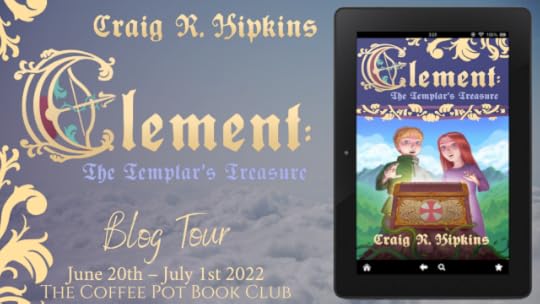
It's #HistFicThursdays again, and this week I'm thrilled to be sharing a guest post from Craig R. Hipkins, as part of his Coffee Pot Book Club tour. Find out what research drew him into the world of Clement and Dagena, Viking exploration, and linguistic adventures...
Blurb
Clement & Dagena return for another action packed adventure. From the cold and dreary shores of Greenland to the fabled land of Vinland. The legendary treasure of the Knights Templar awaits.
Clement: The Templar's Treasure is available via this Universal Link
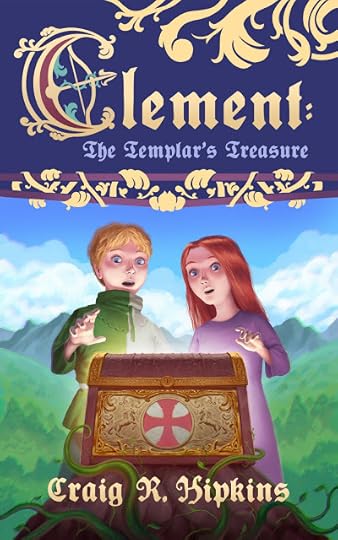
Guest Post
Clement: The Templar’s Treasure is set in the middle of the 12th century. This was at the height of the age of chivalry when the troubadours sang their poetry and martial tournaments were the rage over all Europe. Although the first book in the Clement series concentrated on historical elements related to the continent, the second and third installments took Clement far away from the kingdoms of Europe. However, chivalry, a common theme in the series followed Clement to Greenland and then to North America.
I have always been fascinated by the Norse voyages of Erik the Red and Leif Erikson. I used the knowledge I have of them to good advantage in the book. The Norse sagas mention a land west of Greenland which Leif called ‘Vinland,’ where the wild grapes grew in abundance. I conveniently used this place as the final destination for Clement and his friends. I was aware of a theory that historians have debated for decades regarding the location of Vinland. Grapes do not grow anywhere the Norse were known to have explored. A possible solution to this conundrum is that Leif and his men had traveled as far south as Cape Cod in Massachusetts. It is here where there are cranberry bogs. It is therefore plausible that Leif mistook the cranberry as a wild grape. This theory makes sense, but absolute proof that Vinland and Cape Cod are the same is lacking.
Another topic that I researched while writing this novel involved the indigenous culture in Massachusetts Bay at this time. I did take a little literary license regarding the native tribes, as not much is known about the Wampanoag and Nipmuck nations before the English colonized Massachusetts in the early 17th century. It is from this time period that I immersed myself in reading. I studied the day-to-day existence of life in New England prior to European settlement and used this knowledge in great detail in my book. It was a bit of a challenge, but I took great pleasure in bringing these details to light. The Wampanoag and Nipmuck spoke a dialect of Algonquin, a language that is now all but extinct. However, certain words have survived through the generation and have made their way into the English lexicon. Of course, like any language, it is almost certain that the Algonquin tongue evolved over time and that the few words I took the liberty of using in the book probably did not exist in the 12th century.
Overall, I thoroughly enjoyed the hours of research that I spent while working on Clement: The Templar’s Treasure. I hope that people will enjoy reading it as much as I enjoyed writing it.
Now, let's meet the author:

Craig R. Hipkins grew up in Hubbardston Massachusetts. He is the author of medieval and gothic fiction. His novel, Adalbert is the sequel to Astrolabe written by his late twin brother Jay S. Hipkins (1968-2018) He is an avid long-distance runner and enjoys astronomy in his spare time.
You can follow Craig on these links:Website - Twitter - Facebook - LinkedIn - Instagram - Pinterest - Amazon Author Page - Goodreads
Keep up with the rest of the Clement: The Templar's Treasure tour stops by clicking on the banner below:
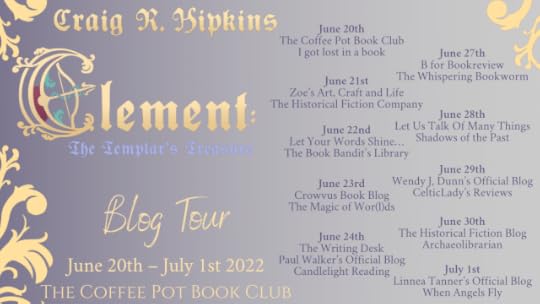
June 15, 2022
#HistFicThursdays - But One Life: The Story of Nathan Hale - Samantha Wilcoxson
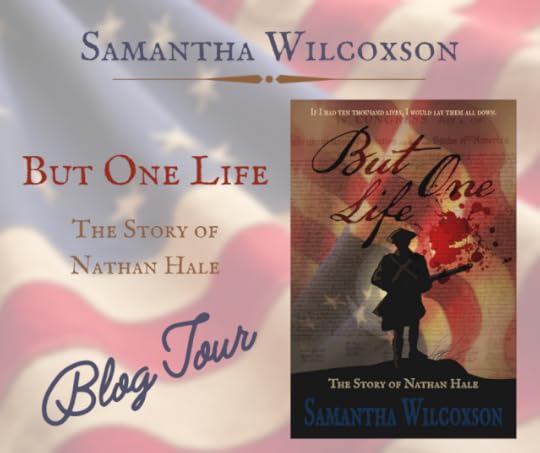
Today it is my absolute pleasure to share with you Samantha Wilcoxson's new release, But One Life: The Story of Nathan Hale. I have to admit, being from this side of the pond, Nathan Hale is not a name I was familiar with, but I have loved sharing in Samantha's posts in the lead-up to the launch and feel I now know this inspiring individual rather well.
Let's meet the book...
Revolution. Friendship. Sacrifice.
But One Life: The Story of Nathan Hale is an intimate retelling of the life of a great American patriot. As a young man, he debated philosophy at Yale and developed his personal politics of the revolution. Shortly after graduation, he joined the Continental Army and volunteered a spy in 1776. How did Nathan become a man willing to sacrifice himself with just one regret – that he had but one life to give for his country?
Experience the American Revolution alongside Nathan, his brother, Enoch, and good friends like Benjamin Tallmadge. They dream of liberty and independence. But at what cost?
Friendship, faith, love, and loyalty motivate young Nathan to become a name recognized throughout America as the quintessential patriot.
If I had ten thousand lives, I would lay them all down.
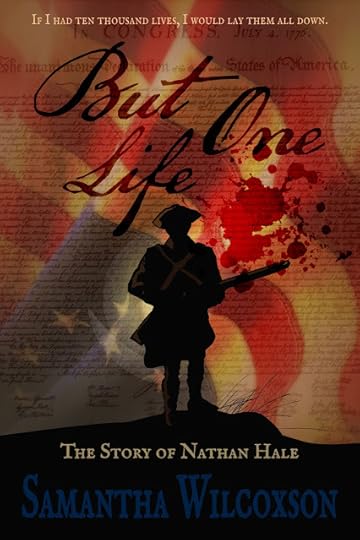
***You can buy the book here: Universal Link***
Praise for But One Life:[taken from reader reviews]
I am so honored to have read this book and my life is richer for having consumed it. Samantha Wilcoxson is very gifted and I thoroughly enjoyed reading But One Life.
If you've not had the pleasure of reading any of Samantha's books, I urge you to start with this one as an example of her beautiful, emotive writing. Will you have your heart stomped on? Most definitely, yes. But the pain is worth the bittersweet beauty you'll uncover on the way. And you'll make a new friend in Nathan Hale.
The author does a masterful job of imagining the life of Nathan Hale and the choices that he made to help gain independence for our nation.
Now, let's meet the author...
 Writer of historical fiction and sufferer of wanderlust, Samantha enjoys exploring the past. She strives to reveal the deep emotions and motivations of historical figures, enabling readers to connect with them in a unique way. Samantha is an American writer with British roots and proud mother of three amazing young adults. She can frequently be found lakeside with a book in one hand and glass of wine in the other.
Writer of historical fiction and sufferer of wanderlust, Samantha enjoys exploring the past. She strives to reveal the deep emotions and motivations of historical figures, enabling readers to connect with them in a unique way. Samantha is an American writer with British roots and proud mother of three amazing young adults. She can frequently be found lakeside with a book in one hand and glass of wine in the other.You can keep in touch with Samantha on these links:Twitter - Blog - Amazon Author Page - Instagram - Facebook - Pinterest - Goodreads
Crowvus Book Blog
- Virginia Crow's profile
- 128 followers


